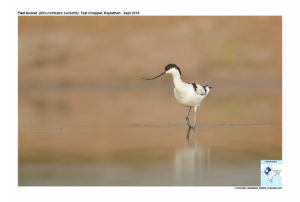Pied Avocet

Pied Avocet Recurvirostra avosetta
Etymology:
- Recurvirostra : Latin bird recurvus bent backwards derived from recurvareto bend ; rostris-billed
- Avosetta: Venetian name Avosetta for the Pied Avocet
Vernacular names: Hindi: Kusyachaha, Sans:Kashika, Guj:Ulti-chanch, Mar: Uchatya, Ta: Kuniarichan, Mal: Avocet
Distribution in India: Breeds in Kutch and widespread winter visitor and passage migrant in India.
Description: Size of 42-45 cm; wt. of 195-397 g; wingspan of 77-80 cm. It is white with black forehead, crown to below eyes, nape and upper hindneck. At rest,it shows three distinctive black bands on mantle and scapulars, lesser and median upperwing-coverts, and outer six primaries. The bill is black and strongly upcurved andlong legs areblue-grey. Thefemale tends to have shorter, more strongly curved bill. Juvenile similar to adult, but black is less intense or tinged brownish and white upperparts have mottling of sepia, grey-brown or buff.
Habitat: It breeds in flat, open areas typically at shallow saline lakes, lagoons, pools, salt pans and estuaries with sparse vegetation. Outside breeding season it also frequents muddy tidal flats. Found from ground level to over 3000 m.
Food habits: It is Carnivorous and eats aquatic invertebrates like insects, crustaceans and worms, molluscs, fish and sometimes plant material like seeds and small roots. It mostlyfeeds by picking or by tactile scything of bill through water or mud. It sometimes feeds communally, occasionally compact groups spinning around almost frantically on their own axis. It sweeps through water at a rate of 28 sweeps/minute to 46 sweeps/minute. Regularly feeds at night, irrespective of tidal regimes.
Breeding habits: They breed in Apr–Aug in Eurasia; Jan, Apr, Jun–Jul in E Africa; Aug in Zambia and Jul–Nov across S Africa. It is seasonally monogamous, with pair-bonds apparently formed in late winter, prior to arrival on breeding grounds. The nest is typically a grass-lined scrape sometimes with a raised rim and also lined with feathers, in open ground or amongst short vegetation. They lay a clutch of 3–4 eggs laid at 24–48-hour intervals. The incubationis 23–25 days. The incubation is done by both sexes, starting with second or third egg. The chicks is nidifugous andfledgingperiod is 32–42 days. The young gather in small crèches of up to 20 birds tended by 1–2 adults. Birds that breed in semi-natural locations often lead young to nearby natural wetlands, during which process predation is common.